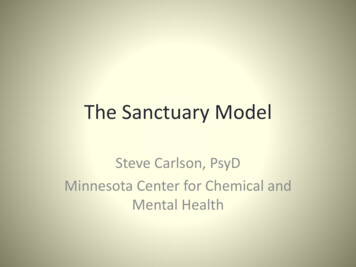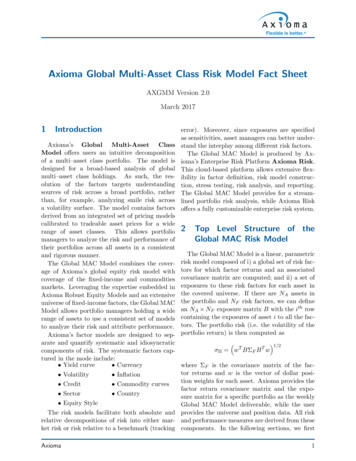
Transcription
The Sanctuary ModelSteve Carlson, PsyDMinnesota Center for Chemical andMental Health
Sanctuary
Once upon a time TherapeuticCommunitiesThe Friends Retreat, York, England, 1796.
“ the idea of Sanctuary is make-believe”“There is no perfect organization. Few of us haveexperienced emotionally intelligent environmentsof perfect safety, where honesty and opennessprevail and there are no secrets, where continuouslearning from conflict is the norm, where decisionsare routinely made by democratic consensusbalancing individual needs with the common good,where justice is accorded to everyone, or whereloss is compassionately understood and honored asa key factor in change and everyone shares in adrive toward a better future.”Sandy Bloom
“And yet, we can imagine suchan organization, such a society,such a world.”
Books by SandraBloom and BrianFarragher Creating Sanctuary:Toward the Evolutionof Sane Societies(1997) DestroyingSanctuary: TheCrisis is HumanServiceOrganizations (2011) RestoringSanctuary: A NewOperating System forTrauma InformedSystems of Care(2014)“It starts with a dream.”
MohandasGandhi
“Sanctuary is a place of refuge from danger, threat, injury,and fear. It has been recognized since ancienttimes—and scientific research has validated—that for physical and emotional healing to occur,people need such a protected space in order toallow time, healers, and the natural powers ofrecovery to work their magic.”From, Destroying Sanctuary
In a nutshell .Sanctuary is a treatment andorganizational change model that integratestrauma theory with the creation of therapeuticcommunities which provide safety for bothclients and the staff who work with them.
When organizations don’t“change” well Without a clear and healthy change model:– Communication breaks down– Issues go unresolved– Staff experience chronic stress and hyperarousal– Leadership can become authoritarian, or worse,dictatorial– Staff don’t feel safe in the organization– Staff pull into themselves, their offices, or smallcircles of coworkers to protect their jobs and feelsafe
Compassion Fatigue, VicariousTraumatization, Burnout Numbing, loss of feeling, feeling detachedExaggerated sense of arousal, irritabilityConcentration problemsLoss of meaningSocial withdrawal, disconnection fromimportant people Encapsulation
The organization is aliving, growing,changing systemwith its own uniquebiology.It is therefore everybit as susceptible tostress, strain &trauma as theindividuals who liveand work in theorganization.Complex interactionbetween traumatizedclients, stressed staff,pressuredorganizations, andoppressive social andeconomicenvironment.
ClientsStaffFeel FragmentedOverwhelmedConfusedDepressedFeel onIs unsafePunitiveStuckMissionlessCrisis DrivenFragmentedOverwhelmedValuelessDirectionless
In a nutshell .Sanctuary is a treatment andorganizational change model that integratestrauma theory with the creation of therapeuticcommunities which provide safety for bothclients and the staff who work with them.
The Four Pillars of Sanctuary Trauma TheorySanctuary CommitmentsS.E.L.F.Sanctuary Toolkit
What is Trauma Informed Care? An appreciation for the high prevalence oftraumatic experiences in persons who receivehuman services ACES study (Adverse Childhood Experiences) A thorough understanding of the profoundneurological, biological, psychological and socialeffects of trauma and violence on the individual Changing the culture of an organization(Jennings, 2004)
Reenactment“In my distrust,I am preparingfor some kindof tragic,horriblebetrayal thathas alreadyhappened”AKA Repetition compulsion
Sanctuary Commitments
Commitment to Growth and Change From reenactment (organizational & individualstuckness) to personal growth and change All of us easily fall into habit patterns (helpful ornot) that over time become unconscious to us Habits, once formed, are very hard to change andthen stress makes changing habits even moredifficult Living out within our work a recovery orientation
Commitment to Democracy From oppressive environments to everyone’sparticipation as a personal responsibility This is NOT representative democracy used in running agovernment Everyday processes of hearing from everyone who willbe involved in the decisions that affect their lives Tools needed for democratic participation––––––Expressing oneselfDeeply listening to othersConflict managementCompromiseSelf-control, self-discipline, self-respectRespect for others – are taught and modeled in theorganization
Commitment to Nonviolence From hostile environments (including microaggressions) to hospitality (physical, social, moral,and psychological safety) Commitment to Satyagraha nonviolence – refusalto retaliate with physical or psychologicalviolence Bullying behavior is addressed whenever itemerges in the organization, regardless of who isengaging in this behavior Since safety is valued, violence in all its forms, isseen as stupid, even boring, and everyone learnsto manage conflict productively
Commitment to Emotional Intelligence From disregulation/flooding (chronicorganizational hyperarousal) and reactivity toemotionally intelligent responses– “Emotions are among the primary determinants ofbehavior at work and profoundly influence both thesocial climate and the productivity of companies andorganizations” R. Pekrun and M. Frese *– William Blake referred to emotions as, “DivineInfluxes”. Leaders understand that a key part of their job isto recognize, contain, and manage emotions intheir organization
Commitment to Social Learning From top-down directing to a “living-learning”environment Everyone – clients, staff, leaders – is expected tolearn and contribute to the learning of others allthe time Before we can learn from new experiences, wehave to become aware of, articulate, and unlearnestablished patterns and routines A learning organization is one that adapts tochanging conditions, that expects all employeesto be learning all the time, and that values allstaff members and includes everyone in thelearning environment
Commitment to Open Communication From secrecy to organizational &interpersonal transparency Everyone communicates directly and, as muchas possible, uses words to convey what theymean Leaders not only practice the ability to handledissent when it occurs but to actually searchfor it. What are the organizational “undiscussables”?
Commitment to Social Responsibility From the “reciprocity rule” (react as the otherdid, and expect the other to do as you did) to acommitment to balancing individual rights andresponsibilities with the rights andresponsibilities of the community Includes– Distributive justice (how resources are allocated)– Procedural justice (principles that govern decisionmaking processes, rewards and punishments)– Interactional justice (how one person treats another). Shared ethical principles are the basis for ourfamilies, our institutions, and our society – inword and deed
SafetyFutureEmotionLoss
S.E.L.FA way oforganizingcomplexityDynamic andnonlinearPhases you movein and out of, notstages you climbAn accessiblelanguageGets everyone onthe same pageApplicable tochildren, adults,families, staff andorganization
Physical safety: Your body is safe from physical harmPsychological safety: You are safe with yourselfSocial safety: You are safe with other peopleMoral /ethical safety: You and other people in your community aresafe and consistent with your conscience, beliefs,values
eemSelf-empowermentSelf-controlSelf-discipline
Giving words for feelings: Mad, Sad, Scared, Glad,ShamedNeither expressing nor suppressing, but managingTrading in actions forwords
Managing Losses“When youlive next to thecemetery, youcan’t cry foreveryone whodies.” Russian Proverb
GrievingSaying goodbyeRefraining fromReenactmentMoving on
Changing trajectoriesNew attractorsDifferent choicesImaginationVision
“What happened to you?” instead of“What’s wrong with you?”More time for the solution than theproblem.All attendees are expected to participatein giving information and posingquestions.
Fosters asharedlanguage
Community meetingsPsychoeducation GroupsRed Flag MeetingsSelf Care PlansTeam MeetingsTreatment Planning ConferenceSafety Plans
Safety PlansSelf-care begins with self-compassion What do you do for self-care? At work care?– Talk with a trusted friend– Quiet walks by yourself– Time and space for meditation– Some light exercise– Opportunities to laugh offered by movies, cheerfulfriends & colleagues, etc– A hobby such as gardening or knitting– Spiritual and recreational reading– Listening to music you enjoy
J. Goldstein, 1994The Unshackled Organization
Steve Carlson, PsyDcarlsos@umn.edu
–Quiet walks by yourself –Time and space for meditation –Some light exercise –Opportunities to laugh offered by movies, cheerful friends & colleagues, etc –A hobby such as gardening or knitting –Spiritu










